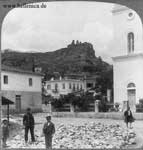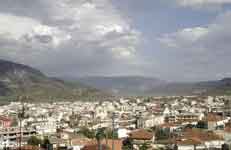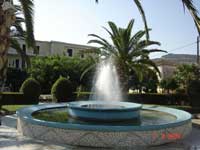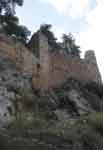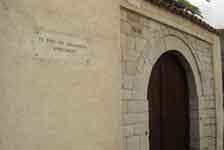.
Administrative Region : Central Greece
Regional unit : Fokida
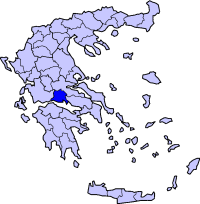
Amfissa (Greek: Άμφισσα, [ˈamfisa], mentioned in classical sources as Amphissa) is a town and a former municipality in Phocis, Greece. Since the 2011 local government reform it is part of the municipality Delphi, of which it is the seat and a municipal unit.[1] It is also the capital of the regional unit of Phocis. Amfissa was known as Salona (Greek: Σάλωνα, [ˈsalona]) in the Middle Ages.
Amfissa sits on the northern edge of the farmlands of the Crissaean plain, and lies between two mountains; Giona to the west and Parnassus to the east. The town itself is surrounded by an olive forest, and located south of Lamia, northwest of Livadeia and Delphi, 13 km (8 mi) north of the port of Itea, 30 km (19 mi) north of Desfina, northeast of Naupactus and east of Lidoriki. The town has access to Greek National Road 27, and the GR-48 links it to Lidoriki.
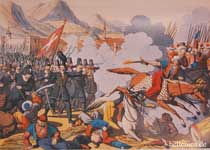
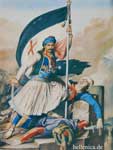
Battle of Salona, Mitropoulos in Salona,
Origin of the name
It is believed that the name of the city derives from the ancient Greek verb αμφιέννυμι (amfiennymi), meaning 'surround', as it is surrounded by the mountains Giona and Parnassus. In Greek mythology, Amfissa, the daughter of Macar, son of Aeolus, and mistress of the god Apollo, gave her name to the city.
During the Latin occupation in the 13th century a fortress was built above the city, and first it and then the city came to be called Salona.[2]
There are three folk etymologies given for the name, none of which are correct:
It derives from the word salos (σάλος), meaning 'shake', as the region was frequently hit by earthquake,
It is a comptroller of the word Saloniki (Thessaloniki), after which the king of Thessalonica, Boniface of Montferrat, renamed Amfissa
It is a corruption of the term esalona (εσάλωνα), used in agriculture to mean 'inland threshing floor'.
In 1833, the initial name of the city, Amfissa, was brought into use once more.
History
Ancient times
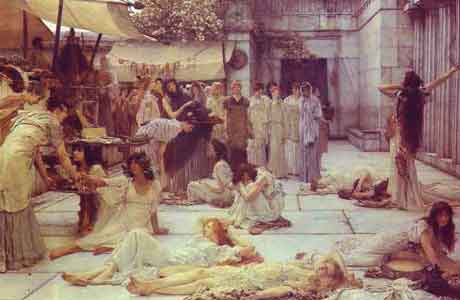
Women of Amfissa protect Maenads from Delphi who entered in their city according to a story of Pausanias. Alma Tadema.
Amfissa has been settled since the ancient times and was the chief town of Ozolian Locris, a region inhabited by the ancient Greek tribe of Locrians; the largest and most renowned town of Locris, beautifully constructed and located one hundred and twenty stades away from Delphi. Pausanias, in his work Description of Greece, mentions the existence of the tombs of Amfissa and Andraemon, and the temple of Athena on the acropolis of the town, with a standing statue of bronze, which was said to have been brought from Troy by Thoas. The Amfissians celebrated mysteries in honor of the "anaktes boys", who might be the Dioskouroi, the Curetes or the Cabeiri (10.38). In Amfissa there were also the tomb of Gorge, wife of Andraemon, and the temple of Asclepius.
Findings of several excavations revealed that the town had developed its commerce with Corinth and towns of the northwestern Peloponnese at the end of the 8th century BC. Amfissa was organised as polis in the 7th century BC and flourished in arts and trade, which lasted for three centuries. Parts of the walls of the ancient acropolis of the town date back between the 7th and the 6th century BC. In 653 BC, people from Amfissa migrated to Southern Italy and founded the town of Epizephyrian Locri. Amfissa's calendar differed from that of the other Ozolian towns,[3] while four of the months' names known are Argestyon, Panigyrion, Amon and Pokios. Its coins had the head of Apollo on the one side, and the inscription "ΑΜΦΙΣΣΕΩΝ" (Amfissians'), a spear-head and a jaw-bone of Calydonian boar, and either a star or grapes on the other.[4]
Women of Amfissa, by Lawrence Alma-Tadema and Laura Theresa Alma-Tadema (1887).
Following the Greek defeat by the Persians in the battle of Thermopylae, the Persian troops invaded Phocis, Ozolian Locris, Doris and Boeotia. It is then that Amfissa, due to its strong acropolis, received Phocians seeking for safety. During the Peloponnesian War, Amfissa fought on Sparta's side, drifting the other towns of Ozolian Locris in this way. The town's form of government was oligarchic, similar to that of Sparta, but, during the Pericles' era in Athens, some unsuccessful attempts to establish democracy took place. Ten of the archontes of Amfissa have been known through inscriptions found at Delphi: Theagenes of Menandros, Voriadas, Charixenus, Aristodamus of Damon, Dorotheus, Euarchus, Archedamus, Aristodamus of Epinicus, Charixenus and Aristarchus.
In 426 BC, Spartan general Eurylochus, on his way to Naupactus, arrived to Delphi and sent a herald to Amfissa, in order to detach them from Athens and make the Amfissians leave him pass through their lands. The latter were the first to give him hostages and also persuaded the other Locrian cities to do the same, as they were alarmed at the hostility of the neighbouring Phocians. After the Peloponnesian War the Amfissians were allies to Thebes. In 395 BC, the Thebans encouraged the Amfissians to collect taxes from territories claimed by both Locris and Phocis; in response, the Phocians invaded Locris, and ransacked Locrian territory and its metropolis, Amfissa. As a result, the Amfissians and the rest of Locrians, along with the Thebans, attacked Phocis, and the Phocians, in turn, appealed to their ally, Sparta. These conflicts led to the Corinthian War, with the Amfissians on the side of Athens, Argos, Corinth and Thebes.
During the Third Sacred War, 356 - 346 BC, the Amfissians, who were allies of the Thebans, cultivated part of the Crissaean plain, which belonged to Delphi, and founded potteries in Kirra. In 339 BC, the Athenians offered golden shields to the Temple of Apollo in Delphi with inscriptions insulting to the Thebans, who provoked the deputy of Amfissa to oppose to this offer. Then Aeschines, the Athenian deputy, contradicted the Amfissians, introducing their illegal actions in the sacred lands of the Oracle of Delphi before the Amphictyonic League, which called Philip II of Macedon to interfere. In 338 BC, Philip attacked and destroyed Amfissa, expelling large parts of its population and giving the area to Delphi, which is known as the Fourth Sacred War. Later in the same year, under the motivation of Demosthenes, a confederation of the Athenians and the Thebans was organized against the Macedonians, which the Amfissians and the rest of the Ozolian Locrians joined.
Sites of interest
The Amfissians managed to rebuild their town and give to it its former power, but in 322 BC it was sieged by Alexander of Aetolia. In 279 BC, four hundred Amfissian hoplites joined the Greek forces which defended Delphi against the Gauls. Later, the Amfissians and the Aetolians tightened their old affiliation, and in 250 BC, Amfissa joined the Aetolian League as friend and relative of the Aetolians. In 245 BC, Aratus, the strategos of the Achaean League, attacked and damaged Amfissa, but the two leagues allied with the Roman general Titus Quinctius Flamininus against Philip V of Macedon, and after their win over the Macedonian king, Titus proclaimed Amfissa, among other cities, as an independent and tax-exempt polis, capital of Ozolian Locris, with its own Boule, Ecclesia and coins. But when the Aetolians realised that Rome was to rule the Greek cities and asked Antiochus III the Great of Syria for help, the Roman general Manius Acilius Glabrio seized Lamia and advanced to Amfissa, where he conquered the Crissaean plain and besieged the town in 190 BC. The Amfissians, being confident for the power of their acropolis and their walls, defended the city, but the fall of Amfissa to the superior forces of the Romans was likely to happen. Then, Manius Acilius was replaced by Lucius Cornelius Scipio Asiaticus, and the people of Amfissa ran into the acropolis. Athenian deputies intervened and prevented Amfissa from the siege, achieving a truce between the two sides.
In the period between 174 and 160 BC, Amfissa had been damaged several times during the hostilities which took place between the pro-Roman Aetolians and the nationalists of the town. When Octavian founded the town of Nicopolis, in memory of his victory over Antony and Cleopatra in the battle of Actium, he drove Aetolians to populate it but the parts of them moved to Amfissa. That is why Pausanias says that the Amfissians were ashamed of calling themselves Ozolians, thus they claimed Aetolian descent, a fact that was a misconception of Pausanias, because some people of Amfissa in his times were indeed descendants of Aetolian refugees. In that period, Plutarch mentions, in the work Parallel Lives, a physician from Amfissa named Philotas (Marcus Antonius 28). During the 2nd century, Amfissa was a prosperous town which expanded outside its walls, having a population of 70,000 people in 180 BC according to Pausanias, while during the reign of Diocletian, Amfissa is said to have a splendid aqueduct.
Middle Ages
In the early Middle Ages, Amfissa was devastated by several foreign peoples who invaded Greece, like the Visigoths under Alaric I and the Huns. In 451, the town probably had an episcopical seat and in 530, Justinian I fortified the towns around the Crissaean plain and fixed the fortress of Amfissa. Hierocles in his Synecdemus mentions Amfissa as one of the towns of the eparchy of Hellas within the Byzantine Empire, which was under the rule of the vice-consul of Athens.[5]
Since the middle of the 9th century, new invaders, the Bulgars, raided the region of Phocis and sieged Amfissa several times, but the most damaging was in 996, when Samuel of Bulgaria destroyed the town and slaughtered its people. in 1059, Pechenegs besieged Amfissa one more time and forced the Amfissians to hide in caves of the region to avoid a massacre. In 1147 the Normans arrived to the Crissaean plain but left Amfissa unspoilt, maybe due to the town's decline.
In 1205, after the Fourth Crusade and the establishment of the Latin Empire, Boniface of Montferrat, the king of Thessalonica, conquered the region of Central Greece. It is then that the new governors built the powerful Castle of Salona on the hill where the ancient acropolis of Amfissa existed, while the ancient name of the town was replaced by the new name Salona, and the new Lordship of Salona was referred to as "La Sol". In 1311, the Catalans conquered and ruled Central Greece for more than eighty years.
Ottoman era and the Greek War of Independence
Nikos Mitropoulos hoists the flag at Salona. Painting of the capture of the city by the Greek revolutionaries in 1821, by Louis Dupré.
The region of Salona was conquered by the Ottomans in 1394. In 1580, a huge earthquake destroyed several towns in Phocis, amongst them Salona. After a period of Venetian rule from 1687 to 1697, Salona devolved to the Ottomans again; several foreign travellers visited the town, which had about 6,000 inhabitants at the time. Salona had lost the former splendor and nothing was left to remind the glorious past of ancient Amfissa, so as some of the visitors misbelieved that it was the town of ancient Delphi or Kirra. In the 18th century, Salona became the center of preparations for the war against the Ottoman Turks in Central Greece, due to its strategic location and its proximity to the klephts of Giona and Parnassus mountains.
In the Greek War of Independence, Salona was the first town of Central Greece to revolt under the leadership of Panourgias, Giannis Diovouniotis, Ioannis Gouras and its bishop Isaiah, who were in cooperation with Athanasios Diakos, Yannis Makriyannis and others originated from Phocis. On March 27, 1821, Panourgias invaded the town and on April 10 the Greeks captured the Castle of Salona, the first fortress which fell in Greek hands, and extinguished the six hundred people of the Ottoman garrison in it. On 15–20 November 1821, a council was held in Salona, where the main local notables and military chiefs participated. Under the direction of Theodoros Negris, they set down a proto-constitution for the region, the "Legal Order of Eastern Continental Greece" (Νομική Διάταξις της Ανατολικής Χέρσου Ελλάδος), and established a governing council, the Areopagus of Eastern Continental Greece, composed of 71 notables from Eastern Greece, Thessaly and Macedonia. Salona became the capital of Eastern Continental Greece and the regime existed until the Ottoman recapture of Greece, in 1825.
Culture and sites of interest
View of Amfissa in a 1918 postcard.
Much of the town's culture is the result of private legacies left to it; some of the benefactors were Markidis, Giagtzis and Stallos. Landmarks include the Castle of Salona, also known as the Castle of Oria, where the ancient acropolis stood, the Archaeological Museum of Amfissa, the Annunciation Cathedral with its murals by Spyros Papaloukas, several smaller museums and the district of Charmaina where the traditional bells are produced. The Municipal Library of Amfissa, which was founded in 1957, hosts, apart from its large number of books, an impressive[according to whom?] collection of traditional paintings of Phocis. Other older sites are the Byzantine Savior Church, built in the 11th century, the paleochristian baptistery of the 3rd century next to the Cathedral, Lykotrypa which is a Mycenaean tomb on the eastern edge of the town and the Folklore Museum of Amfissa. There are also a TEI (Technological Educational Institute) affiliated to the TEI of Lamia, an IEK and a lyceum. There are ample opportunities for hiking and camping on the mountains. Amfissa contains several plateias, an odeon, a chorus, a public philharmonic, but is also known for its annual carnival.
Historical population
Year City population Municipality population
1981 7,156 -
1991 7,189 9,469
2001 6,946 9,248
Notable people
Alexandros Delmouzos, educator
Christos Karouzos, archaeologist
Aspasia Papathanasiou, actress
References
Notes
^ Kallikratis law Greece Ministry of Interior (Greek)
^ Bon, Antoine (1937). "Forteresses médiévales de la Grèce centrale" (in French). Bulletin de correspondance hellénique 61: 165.
^ "The Princeton Encyclopedia of Classical Sites". Perseus Project. Retrieved 2008-05-08.
^ "Locris". Forum Ancient Coins. Retrieved 2008-05-08.
^ "Hieroclis Synekdemos (Guide)". soltdm.com. Archived from the original on 17 May 2008. Retrieved 2008-05-09.
External links
Official website (Greek)
Official website of Phocis prefecture (Greek) (English)
Primary sources
Pausanias, Description of Greece, online at Perseus Project
Galaxidi Chronicle (Greek)
Secondary sources
Petros Kalonaros, History of Amfissa, 1997
Greece :
A - B - C - D - E - F - G - H - I - J - K - L - M -
N - O - P - Q - R - S - T - U - V - W - X - Y - Z
| Ancient Greece
Science, Technology , Medicine , Warfare, , Biographies , Life , Cities/Places/Maps , Arts , Literature , Philosophy ,Olympics, Mythology , History , Images Medieval Greece / Byzantine Empire Science, Technology, Arts, , Warfare , Literature, Biographies, Icons, History Modern Greece Cities, Islands, Regions, Fauna/Flora ,Biographies , History , Warfare, Science/Technology, Literature, Music , Arts , Film/Actors , Sport , Fashion --- |
Retrieved from "http://en.wikipedia.org/"
All text is available under the terms of the GNU Free Documentation License


